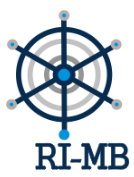
Use este identificador para citar ou linkar para este item:
https://www.repositorio.mar.mil.br/handle/ripcmb/844284Registro completo de metadados
| Campo DC | Valor | Idioma |
|---|---|---|
| dc.contributor.author | Candella, Rogério Neder | - |
| dc.date.accessioned | 2019-12-03T18:25:46Z | - |
| dc.date.issued | 2019 | - |
| dc.identifier.issn | 1616-7341 | - |
| dc.identifier.uri | http://www.repositorio.mar.mil.br/handle/ripcmb/844284 | - |
| dc.description.abstract | One year of deep-water wave hourly records collected by a buoy deployed off Ceará state, northeastern Brazilian coast, were used to estimate some regional wave climate characteristic sand annual cycles. Waves generated by four wind sources were identified. Southeastern direction showed to be the most effective, especially in the period from June to November due to southeast trade winds system intensification. Several dispersive arrivals of north Atlantic swell were recorded, and their generation zones were identified, which allows determining the region of main sources of these northern waves. Analysis of sea storms showed that although most of them had southeast direction, they could also come from the north. These northern storms sometimes are highly energetic, leading to damage in coastal structures. Only 37 records in the analyzed dataset around 0.4% of the total contained rogue waves. Although the number of occurrences of rogue waves was small, all of them were higher than 2.5 m. | pt_US |
| dc.description.abstract | One year of deep-water wave hourly records collected by a buoy deployed off Ceará state, northeastern Brazilian coast, were used to estimate some regional wave climate characteristic sand annual cycles. Waves generated by four wind sources were identified. Southeastern direction showed to be the most effective, especially in the period from June to November due to southeast trade winds system intensification. Several dispersive arrivals of north Atlantic swell were recorded, and their generation zones were identified, which allows determining the region of main sources of these northern waves. Analysis of sea storms showed that although most of them had southeast direction, they could also come from the north. These northern storms sometimes are highly energetic, leading to damage in coastal structures. Only 37 records in the analyzed dataset around 0.4% of the total contained rogue waves. Although the number of occurrences of rogue waves was small, all of them were higher than 2.5 m. | en_US |
| dc.language.iso | eng | pt_BR |
| dc.publisher | Springer | pt_US |
| dc.rights | embargoedAccess | pt_BR |
| dc.subject | Ondas Oceânicas | pt_BR |
| dc.subject | Fortaleza (CE) | pt_BR |
| dc.title | Characteristics of ocean waves off Fortaleza, CE, Brazil, extracted from 1-year deep-water measured data | pt_BR |
| dc.type | journalArticle | pt_BR |
| dc.location.country | nld | pt_BR |
| dc.description.embargo | 2020-11-01 | - |
| Aparece nas coleções: | Hidrografia e Navegação: Coleção de Artigos | |
Arquivos associados a este item:
Não existem arquivos associados a este item.
Este item está licenciada sob uma Licença Creative Commons
